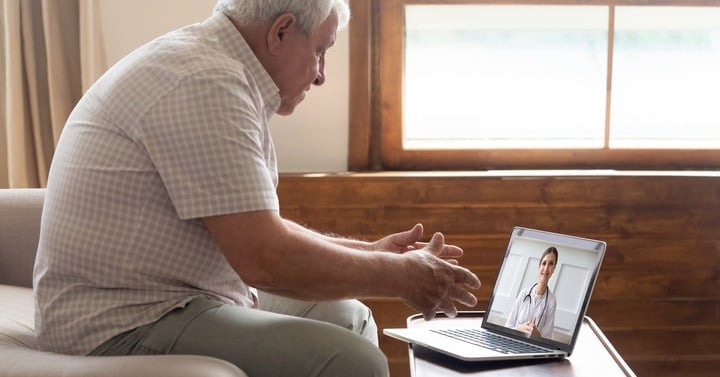How to Improve Patient Engagement in Their Own Healthcare
5 minute read | 30/10/2020

With a surge in telehealth and virtual care, the pandemic has prompted people to engage with their own care in a way the industry hasn’t seen before. Infection-control forced much of the patient journey online, while providers were pushed to find new ways to communicate quickly and clearly.
Patients want healthcare to be simple and convenient but a stark lack of coordination, accessibility and affordability leaves many struggling to navigate the healthcare landscape as intended. Is this about to change? Has COVID-19 been a catalyst? Here’s how to improve patient engagement in their own healthcare.
- Co-Design Where Possible
- Provide Accessible Education
- Conduct Regular Feedback Surveys
- Personalise Care From Start to Finish
Co-Design Where Possible
There are many definitions of patient engagement, but all share an underlying theme: A concept that combines a patient's knowledge, skills, ability and willingness to manage their own health and care with interventions designed to increase activation and promote positive patient behaviour.
A McKinsey patient survey found more than 75% of all patients would like to use digital healthcare services. Empowering patients with modern solutions in healthcare is vital and giving them an active role and access to self-care has the potential to shape their entire hospital experience. When patients can obtain, process and understand information about their health on their own terms, it activates them. So where do we start?
Nobody has all of the answers. Although patients hold key information vital for process, systems and policy improvement, there needs to be more involved with those interacting with healthcare from concept to creation.
Many service improvement projects have patient involvement but co-design focuses on understanding and improving patients’ experiences, as well as the services themselves. In the short term, it reduces development time and improves our knowledge of patients. Long term benefits include better engagement with patients and products as well as increasing the appetite for innovation.
Shared decision-making gives patients a stake in their treatment and can ultimately improve care outcomes. It’s just one step towards navigating the widening inequalities in healthcare, but it’s a huge leap in the direction of better accessibility, inclusivity and personalisation for all.
Provide Accessible Education
A patient can’t meaningfully engage in self-management activities if they’re not familiar with their conditions, treatments and associated health issues. Market-leading systems for hospitals allow patients to take control of their own healthcare. Rather than relying on staff to provide leaflets, patients will have everything they need on their screens in front of them.
This is crucial when trying to reduce the spread of infection during a pandemic.
Diagnosis information, educational videos and information about the treatment or medication they’re going to need can all be accessed. Best of all, this information can all be navigated on the patient’s own device. This means they’re familiar with the device and won’t need to get over the initial hurdle of understanding it.
Our latest addition to the SPARK® Media Platform provides 600 clinically-assured patient information videos, covering a wide range of topics and conditions which aim to help patients be better informed and feel more engaged in their care.
We’ve made the National Health and Care Video Library free for NHS use by NHSX as part of their COVID-19 response and offers patients a visual and easily accessible form of health information. This includes guidance on rehabilitation and how to manage their condition to help prevent readmission.
This will become invaluable as the long term effects of COVID-19 are identified. What’s more, it makes patients happier and their newfound independence also frees up the nurses and doctor's time so that they can focus care elsewhere.
Conduct Regular Feedback Surveys
Collecting information about the patient experience and outcomes of care may be a starting point for engaging patients that can be deployed immediately. To improve patient care, we need comprehensive feedback from those who are involved.
The current issue is giving feedback is somewhat of a challenge, with letters needing to be sent off and patients simply forgetting after being discharged. Intelligent patient engagement systems can prompt them at critical points of their stay, getting the valuable insights you need to shape future care decisions.
These systems offer integrated opportunities for feedback (such as the Friends and Family test). As they’re easily displayed on the screen of the patient’s device or bedside unit, it can be accessed at a time they’re most comfortable.
If you already have legacy systems in place, ask yourself do they support live transcribe services? This is invaluable for presenting information in different ways that might better resonate with patients who have difficulty hearing or with sight.
Most importantly, when improvements are implemented, make sure to communicate that back to those most impacted by the changes. Feeling heard and valued is essential for a patient to be engaged in their own healthcare outcomes.
Personalise Care From Start to Finish
Personalised care means people have choice and control over the way their care is planned and delivered - promoting independence and self-service is just the start. A one-size-fits-all approach doesn’t cut it anymore. Patients are looking for bespoke communications and services to cater to their individual needs.
Besides providing timely education, an example of this is how technology and sophisticated systems can be integrated with a Trust’s meal ordering provider, so patients can order what they want at the touch of a button. This means staff no longer have to visit each ward, potentially asking somebody on nil-by-mouth what meal they’d like.
Plus, as the system links to patients and their ward number, the meals can be redirected if they move or cancelled if discharged, reducing waste and saving costs.
Patients can easily read electronic menus and be aware of the ingredients before they order, another way they can take control of their healthcare journey. Not only that, but it also helps the NHS reduce food wastage (and money).
Going forward, clinicians should aim to develop strong patient education skills, more inclusive decision-making strategies and patient-centric tools to foster meaningful patient activation. There’s no question COVID-19 has changed healthcare, the industry is perfectly poised to harness the change in consumer behaviour and shift towards greater patient engagement.
About the author
Rebecca O'Donovan
Becky is the Marketing Director at SPARK TSL, of whom she has worked for since 2012. She is responsible for high-level marketing strategy focusing on lead generation and aiding the vision of the business to ensure business growth.
More articles by the author
Related articles
 Healthcare Industry
Healthcare Industry
What's Next in Hospital Patient Entertainment Systems? | SPARK TSL
When hospitals started to offer television in the early 2000s, the government saw it as a triumphant drive ...
 Healthcare Industry
Healthcare Industry
Why Your Hospital Needs a Patient Engagement Platform | SPARK TSL
As we venture further into the digital era, patient engagement has become increasingly important for the ...
 Healthcare Industry
Healthcare Industry
How WiFi Can Help Reduce Patient Complaints in Healthcare
By 2019, it will be compulsory for all NHS Trusts to offer free WiFi to patients. Digitalisation is one of ...

